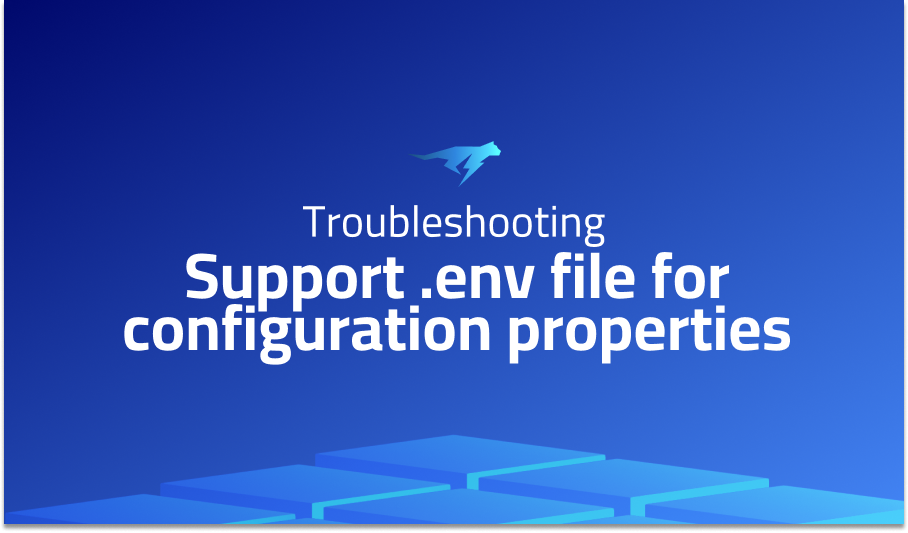

Support .env file for configuration properties
Explanation of the problem
Many developers use .env files to store their application configuration. In order to use an .env file with a SpringBoot application, it is necessary to add the spring.config.import property to the application.properties file. This can be done by specifying the location of the .env file using the following syntax:
spring.config.import=optional:file:.env
However, when this property is added, the application may throw an exception with the following message:
Caused by: java.lang.IllegalStateException: File extension is not known to any PropertySourceLoader. If the location is meant to reference a directory, it must end in ‘/’
This exception is caused by SpringBoot’s inability to recognize the file extension of the .env file as a valid property source. To resolve this issue, it is necessary to configure SpringBoot to recognize the .env file as a valid properties file.
Troubleshooting with the Lightrun Developer Observability Platform
Getting a sense of what’s actually happening inside a live application is a frustrating experience, one that relies mostly on querying and observing whatever logs were written during development.
Lightrun is a Developer Observability Platform, allowing developers to add telemetry to live applications in real-time, on-demand, and right from the IDE.
- Instantly add logs to, set metrics in, and take snapshots of live applications
- Insights delivered straight to your IDE or CLI
- Works where you do: dev, QA, staging, CI/CD, and production
Start for free today
Problem solution for Support .env file for configuration properties
This code will tell Spring Boot to use the .env file as an optional properties file. The .properties hint indicates that the file should be treated as a properties file even if it doesn’t have the .properties extension. This solution has been reported to work for some developers.
In summary, developers who want to use .env as another properties file in their Spring Boot application can add the optional:file:.env[.properties] code to their application.properties file. Alternatively, they can wait for a proposed enhancement to Spring Boot that would officially support .env files. The enhancement would offer a few implementation options to consider, making it easier for developers to use .env files as a configuration source in their Spring Boot applications.
Other popular problems with Spring Boot
Problem: Not using Spring Boot starters
Spring Boot starters are a set of pre-configured dependencies that can be easily included in your project to provide commonly used features, such as database connectivity or security. Not using these starters can lead to a lot of boilerplate code, configuration errors, and missed opportunities to take advantage of Spring Boot’s auto-configuration capabilities.
Solution:
Not using these starters can lead to a lot of boilerplate code, configuration errors, and missed opportunities to take advantage of Spring Boot’s auto-configuration capabilities. To avoid this problem, make sure to use the appropriate Spring Boot starter for your project.
Problem: Not following Spring Boot conventions
Spring Boot is built on top of the Spring Framework, which has certain conventions that are designed to make development easier and more efficient. However, some developers may overlook these conventions when working with Spring Boot, which can lead to issues down the line. One common mistake is not following naming conventions for package and class names. For example, Spring Boot expects packages to be named using reverse domain name notation, such as com.example.mypackage1.
Solution:
To avoid this problem, make sure to follow Spring Boot conventions whenProblem: Unidirectional Many-to-Many relationship mapping
A unidirectional many-to-many relationship occurs when one entity has a many-to-many relationship with another entity, but the relationship is not bi-directional. In this case, it is not possible to navigate from the related entity to the parent entity.
A brief introduction to Spring Boot
Most popular use cases for Spring Boot
- Building web applications: Spring Boot provides a range of features and tools for building web applications, including an embedded servlet container and support for popular web frameworks such as Spring MVC and Spring WebFlux.
- Creating microservices: Spring Boot is well-suited for building microservices due to its ability to create lightweight, stand-alone applications with minimal configuration. It also provides features such as service discovery and externalized configuration to support the development of distributed systems.
- Accessing data: Spring Boot provides support for a range of data access technologies, including JDBC, JPA, and NoSQL databases. It also offers auto-configuration for common data access components and provides a consistent data access API through the Spring Data project.
It’s Really not that Complicated.
You can actually understand what’s going on inside your live applications.




